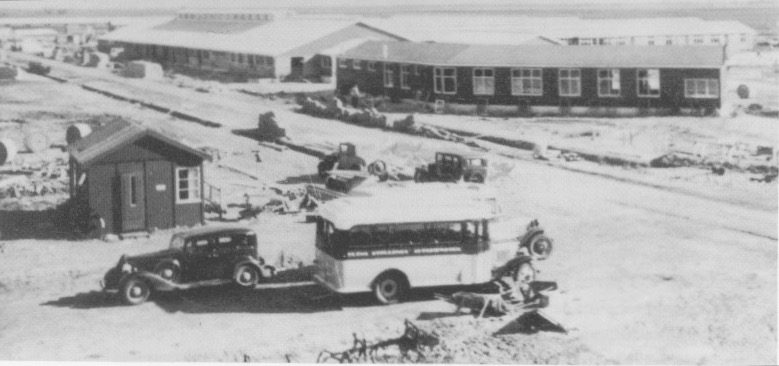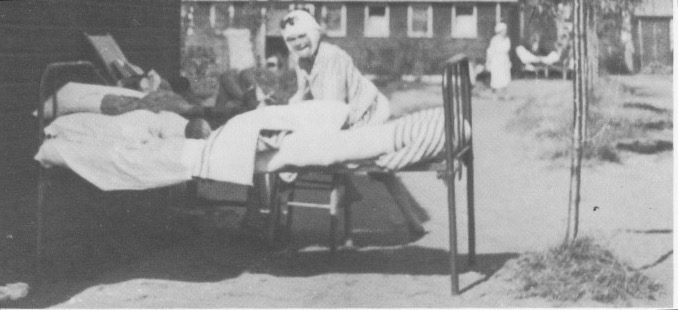Annabelle S. Slingerland
Leiden, the Netherlands
 |
| Westerbork Hospital from the outside |
This year Westerbork Hospital in the east of the Netherlands celebrates its seventieth anniversary, not of its birth but of its closure. Despite its well-deserved reputation for medical care, it was part of Polizeiliches Durchgangslager Westerbork, a Nazi concentration camp that held persons selected for transport to the death camps.
The hospital grounds were originally known as Centraal Vluchtelingenkamp Westerbork, a camp for refugees arriving mainly from the neighboring country, Germany. It was those refugees themselves who in 1939 built Barrack No. 12 and converted it into a hospital equipped with little more than tweezers and scissors.
When German troops invaded the Netherlands in 1940, the number of refugees increased dramatically. Again, they took the initiative to adapt to the circumstances by building one barrack after another, stacking bunk beds three rows high, training childless women and men for medical duty, organizing a hygienic service, De Hygienisch Dienst, to prevent outbreaks of disease, and coordinating with other medical centers such as Groningen and Assen. They also collaborated with the Rijksmagazijn voor Geneesmiddelen, providing all the medications as well as with Appeldoornsche Bosch, which cared for mentally handicapped children.
Freedom remained crucial. The community lived as normal a life as possible under the circumstances. The refugee camp was still administered by refugees, who were immediately replaced if they used harsh language or manners. The camp was protected from the outside world by merely a few watchtowers and a simple barbed wire fence. Men worked outside the camp under relatively good conditions with one guard per sixty workers; women could go shopping in the nearby town of Assen; and patients could visit the academic center in the town of Groningen. Contacts were maintained with family members outside by sending each other letters and parcels. Inhabitants coupled up and numerous babies were born. ‘Panem et circenses’ provided good and plentiful food, sports, and cabaret. Johnny and Jones, once teenage music stars now interned in Westerbork, even wrote the Westerbork Serenade, an ode that became a number one Hit Parade song. The pair were even allowed the freedom to travel to a recording studio in Amsterdam.
 |
| Westerbork Hospital, including its patients |
Newcomers, exhausted from the journey and numbed by a year-long process (they had been isolated, stigmatized, segregated and now “concentrated” as human beings culled from the Third Reich) were too dumbfounded to see or even imagine deportation coming. Instead, the hospital with its comforts and its premises was perceived as a welcoming Fata Morgana.
Then something changed. Rumors of transport of a random sampling of inhabitants to an unknown destination were received with unease. Indeed, on July 15, 1942, several of the 2,030 inhabitants were walked to the nearest train station departing east, in the direction of Germany.
The tension drove some to suicide the night before transport. Others fell instantly ill. Still others convinced officials to keep their names off the “list” that denoted those who, along with their precious few belongings, had to board a train heading east. The understanding that they were going to a working camp in the east only temporarily eased the tension until the names of women, children, and the elderly began appearing on the weekly transport list… trust that came slowly, left quickly. Moreover, not all doctors, officials and managers were as reliable or cooperative as their vocation would demand. And those who were up to snuff were left empty-handed. Inhabitants remained intuitively suspicious. The grim irony of saving lives so that the successfully treated patients would be healthy enough to travel to what could be their doom cannot have escaped their notice. Had doctors sought solace through increased devotion to their life-saving and care-giving duties as an escape? An incubator to save a premature baby, preventing suicide, rubbing thermometers to simulate fever, women described as being in advanced stages of pregnancy…while others were left to their fate.
The same grim irony was seen in managers, whose duties included matching increased influx with increased outflow. The inhabitants, regardless of whether they had any medical training, tried to befriend the managers in order to obtain jobs in the hospital, still considered the safest haven. Their names on the “Stammliste” would provide a “Sperre,” or barricade, thus postponing their transport…
 |
| Westerbork Hospital barrack |
Regardless what happened to individuals, the quota of eastward bound train passengers remained the same. Hence it was a zero-sum gain, a temporary gain in vain: doctors would save one person slated for deportation only to see someone else’s name appear on the list instead. Rather than focusing on healing, physicians and managers found themselves prioritizing some patients at the expense of others, trying to juggle the influx against the output of bodies for transport, and numbing themselves to the ultimate consequences of their actions. Interestingly, neither doctors nor managers endeavored to reduce the influx of new patients, since they realized it was a fool’s errand. Determining whom to send to the camp was a task for others who outranked them!
While focusing on the here and now enabled many to cope, over time those who had had the opportunity to visit other hospitals were privy to rumors of gas chambers and received offers of assistance from civilians should they dare to escape. Although only a few understood the harsh reality of the inhuman horrors, fewer still dared to attempt to escape, lest their barrack fellows or family members be punished in their stead. Even fewer eventually escaped directly from the premises, spontaneously during one of the outings, or from the train or even the next camp, without being captured and returned.
Moreover, as soon as the head of the camp noticed suspicious behavior, doctors, managers, and inhabitants came under closer supervision as he tightened the screws. Outings were more heavily escorted and controlled, and the inhabitants still in custody overcame the urge to escape. Hopes of holding on until the end of the war won out.
While the doctors and managers had their heads in the sand, the harsh reality finally hit home in October 1942. A tsunami of new patients, including their doctors and nurses, inundated the camp. Jewish hospitals and nursing homes had been emptied straight into Westerbork’s hospital. This flooded the hospital’s capacity, created shortages, chaos, and one disease outbreak after the other. Both patients and personnel who fell ill found it hard to recover. Chronic fatigue was endemic. Camp disease and relentless diarrhea were common. Tuberculosis, measles, diphtheria, yellow fever, whooping cough, scarlet fever, and lice all reigned supreme. Quarantine measures became necessary, and provided one last reason to delay transport. Escape was now virtually impossible. Suicide attempts increased to around four a week, and though the medical staff again managed to save most, the psychiatric ward in Barrack No. 3 exploded.
 |
| The train of deportation |
Doctors and managers could no longer turn a blind eye to the situation by focusing on their vocation, and hope no longer overcame the pervasive fear. Trust in a working camp was totally lost. Language became harsh, people were piled up on carriages to be brought to the train as if they were cattle. Orders from Berlin and the Hague were obeyed. Many began to find even the train to the death camps an attractive option by comparison.
In the summer of 1943, when the seismic wave had ebbed, personnel became superfluous, so the surviving staff were now transported to the nearby facilities of the Apeldoornsche Bosch. They had to actively participate in evacuating residents, putting them on the trains east, all the while knowing that a trip to labor camps was in fact a three-day journey to death camps such as Auschwitz (54%), Sobibor (34%), Theresienstadt (5%) and Bergen Belsen (5%), which saw the last train on September 13, 1944. Fewer than 5,000 were able to escape on the way or after arrival. Within a two-year period, ninety-seven trains had departed, with 107, 000 Jews and 250 Roma and Sinti.
Westerbork was home to some of the most famous diary writers, whose work has been translated into several languages, among them, Etty Hillesum, Anne Frank, Sinto girl Settle Steinbach, and journalist Philips Mechanicus. The only one to return alive was Ed van Thijn, later a member of parliament and mayor of Amsterdam. After his escape, he stayed with eighteen different families who helped him hide before he was caught again and returned to the camp. Luckily, after he arrived he discovered that the last train to the concentration camps had already left, and together with the 500 residents and newcomers, who had awaited deportation, the ten-year old was held captive against the hostile outside world. This crowd would soon be surrounded by 3,500 Nazi collaborators. Despite his tender years, van Thijn was assigned guard duty over this motley crew.
The allies liberated Westerbork on 12 April, 1945. As Nazi camps go, it had been relatively benign, but the bar for benign was set pretty low. The camp’s very existence calls into question its purpose. Can a physician follow the mandate of the Hippocratic Oath to “First do no harm”, knowing that successful treatment of patients will likely result in their incineration in a Nazi death camp?
References
- Guido abuys, Dirk Mulder, Genezen verklaard voor…: een ziekenhuis in kamp Westerbork, 1939-1945, (Hooghalen/ Assen, the Netherlands: Herinneringscentrum Kamp Westerbork, Koninklijke Van Gorcum, Westerbork cahiers 11, 2006) including interviews with W. Berends ✝, mrs J. van den Berg-van Cleeff (Maarssen), mrs H.Bernstein-Dachs ✝, mrs H.Bing-Rudelsheim (Amsterdam), mrs H.S.Dormits (Den Haag), dr E.Hertzberger (Weesp), mrs S.Jacobs (Scheveningen), A. Katan (Wemeldinge), mrs J.Leget-Lezer (Zoetermeer), E.Lankhout (Amsterdam), R.E.Mannheim (Amsterdam), R.E.Mannheim (Amsterdam), L. Meents (Zaandam), mrs J. Moffie-Bolle (Amsterdam), B. Valk (Groningen) and excerpts from:
- Bob Cahen, Ergens in Nederland. Brief uit kamp Westerbork, 1 november 1942 (Hooghalen, 1988).
- E.A. Cohen, Beelden uit de nacht. Kampherinneringen, (Baarn 1991).
- Etty Hillesum, Het denkende hart van de barak, (Amsterdam 1986, 6de druk).
- W. Lindwer, Kamp van hoop en wanhoop. Getuigenissen van Westerbork, 1939-1945, (Alphen aan de Rijn 1990).
- Philip Mechanicus, In Dépȏt. Dagboek uit Kamp Westerbork, (Amsterdam 1989, 4de druk).
- Dirk Mulder, Ben Prinsen (ed.), Verhalen uit Kamp Westerbork. Westerbork Cahiers 3 (Hooghalen 1995); Lachen in het donker. Amusement in kamp Westerbork. Westerbork Cahiers 4 (Hooghalen 1996); Portretten van overleven. Getuigen van Westerbork. Westerbork Cahiers 6 (Hooghalen 1998); Vluchtelingenkamp Westerbork. Westerbork Cahiers 7 (Hooghalen 1999).
- J. Pressner, Ondergang. De vervolging en verdelging van het Nederlands Jodendom 1940-1945, (’s Gravenhage 1965).
- Fred Schwarz, Treinen op dood spoor, (Amsterdam 1994).
- Sam Stern, Ziekenbroeder in Kamp Westerbork. Getuigen van Westerbork, (Hooghalen 2002).
- H. van der Veen, Westerbork 1939-1945. Het verhaal van Vluchtelingenkamp en Durchgangslager Westerbork, (Hooghalen 2003).
- S. Wyers, Als ik wil kan ik duiken. Brieven van Claartje van Aals, verpleegster in de joods psychiatrische inrichting Het Apeldoornsche Bosch 1940-1943, (Amsterdam zj).
ANNABELLE S. SLINGERLAND, MD, DSc, MPH, MScHSR, Leiden University Medical Center, Leiden, the Netherlands. She could not ignore Westerbork’s 70th Anniversary nor the bundle of letters and messages illustrating how inhabitants and doctors survived the realities of disease and deportation. She thanks Ms. Robin Seeley, John Rolls and Talya Tibbon for their help with this article.
Highlighted in Frontispiece Fall 2015 – Volume 7, Issue 4
Fall 2015 | Sections | Hospitals of Note

Leave a Reply